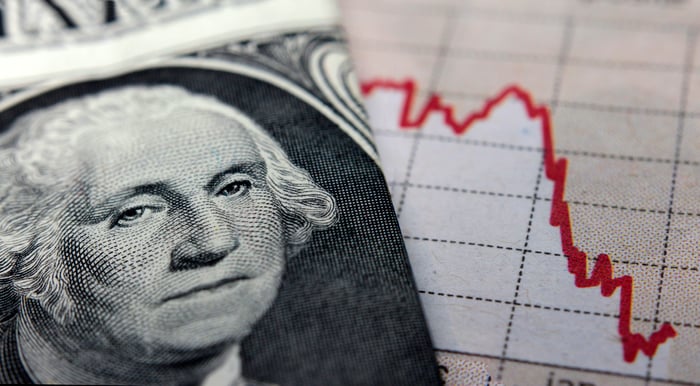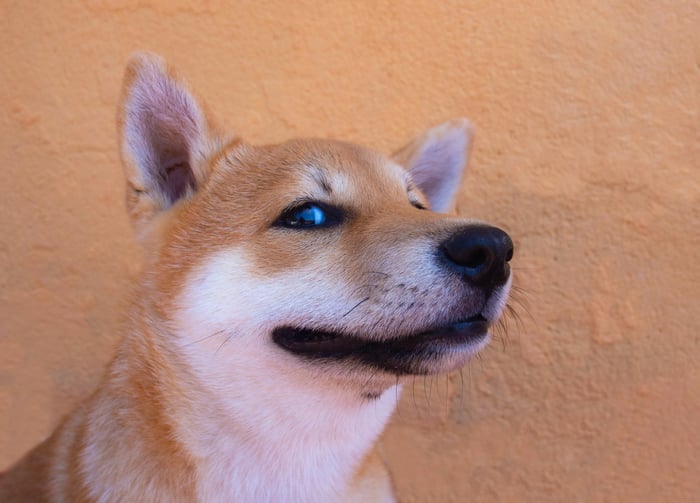
[ad_1]
Over the very long-term, no asset class has been able to hold a candle to the stock market. Even though the stock market has down years, the average annual return of equities leaves bonds, gold, and housing in the dust.
But over a much shorter time frame, cryptocurrencies are the shining star. Since hitting its March 2020 pandemic low, the aggregate value of all digital currencies has increased by nearly $1.1 trillion, or 777%. That laps the performance of the benchmark S&P 500 since March 2020 many times over.
However, not all cryptocurrencies have proved to be winners, or have the competitive edge that’ll allow them to excel over long periods. What follows are five cryptocurrencies investors would be wise to avoid like the plague in June.

Image source: Getty Images.
Shiba Inu
If there’s one crypto project that continues to look wildly overvalued among all others, it’s meme coin Shiba Inu (SHIB -7.60%).
Last year, Shiba Inu delivered what may stand as the greatest single-year return in history — a gain of around 46,000,000%! Aside from social media hype, SHIB tokens benefited from crypto market dynamics. In particular, some crypto exchanges don’t allow short-selling, and there are no derivatives, such as options, for skeptics to use to bet against potentially overvalued coins. The end result was a natural buy bias that made patient Shiba Inu holders millionaires.
But in spite of the hype, Shiba Inu has no shortage of red flags. For example, it offers absolutely no competitive advantages, relative to other tokens, and provides virtually no differentiation. At its core, SHIB is nothing more than an ERC-20 token on the Ethereum (CRYPTO: ETH) blockchain. There’s nothing wrong with ERC-20 coins, but there’s also nothing particularly special about a payment coin. Any of thousands of digital currencies could act as payment coins if merchants chose to accept them.
Coin burn is another misunderstood catalyst for Shiba Inu. Coin burn describes the act of sending tokens to a dead blockchain address where they can no longer be accessed. By removing coins from circulation, every remaining token should, in theory, be worth more. After being given about half of SHIB’s 1 quadrillion token supply, Ethereum founder Vitalik Buterin burned over 410 trillion coins by sending them to a dead blockchain address. While this one event notably reduced Shiba Inu’s outstanding coin supply, there are no other large burn events in the pipeline.
Shiba Inu’s non-fungible token (NFT)-based gaming ambitions might also fall flat. A number of projects have launched NFT-based gaming well before Shiba Inu, and search interest in NFTs has fallen off a cliff over the past four months, according to data from Google Trends.
The final straw is that history has been unkind to payment coins that deliver life-altering gains in a short time frame. It’s quite common for payment coins to retrace 93% to 99%+ in the 26 months following their peak. Considering how much SHIB tokens gained in 2021, an equally large reversion should be expected.

Image source: Getty Images.
Terra Classic, TerraClassicUSD, and Terra (LUNA)
The second, third, and fourth cryptocurrencies to avoid like the plague in June I’ve lumped together, because they’re all part of, or related to, the Terra ecosystem: Terra Classic (CRYPTO: LUNC), TerraClassicUSD (CRYPTO: USTC), and Terra (LUNC).
Once upon a time (i.e., less than a month ago), TerraUSD, which is now known as TerraClassicUSD, was the fourth-largest stablecoin by market cap. Likewise, its native token, Terra (Luna), which is now known as Terra Classic, was the fourth-biggest digital currency in the entire market. Whereas stablecoins traditionally tether themselves to fiat-backed currency, TerraUSD utilized an algorithm that would either mint or burn LUNA to keep itself pegged at $1.
A little over three weeks ago, more than $2 billion worth of TerraUSD was unstaked, with a notable percentage immediately sold. This sale, coupled with poor crypto investor sentiment at the time, de-pegged TerraUSD from $1. Because the Terra ecosystem algorithm allowed 1 UST (now USTC) to always be redeemed for $1 worth of LUNA (now LUNC), the more UST de-pegged from $1, the more of a cascade effect took place due to arbitrage of exchanging plunging UST for LUNA.
Without digging too far into the weeds, the key point here is that TerraUSD, which has been rebranded as TerraClassicUSD, is a completely broken stablecoin with no fiat backing. That makes its native Terra Classic token virtually worthless.
Perhaps the real kick in the pants comes from the hard fork that occurred last week and resulted in the debut of (drum roll) Terra (Luna). TerraForm Labs CEO Do Kwon seems to be hoping that folks will forget about the previous debacle that occurred (checks calendar) 22 days ago, and will welcome this mulligan LUNA coin with open arms. However, all faith in the Terra ecosystem, along with Do Kwan, appears lost, with the new LUNA coin tumbling more than 70% on its first day of trading.
This disaster of an ecosystem has no place in investors’ portfolios.

Image source: Getty Images.
Dogecoin
The fifth and final cryptocurrency to avoid like the plague in June is yet another Shiba Inu-inspired meme coin: Dogecoin (DOGE -6.38%).
Before Shiba Inu began ascending to the heavens, Dogecoin went on a six-month run between early November 2020 and early May 2021, which saw its value increase by more than 27,000%! With Tesla (NASDAQ: TSLA) CEO Elon Musk (aka, the “Dogefather”) owning DOGE tokens, as well as pumping it on Twitter (NYSE: TWTR) as a viable payment option, investors piled into the once joke-worthy coin.
Unfortunately, like Shiba Inu, the hype and valuation surrounding Dogecoin fail to come close to matching its utility.
For example, despite Dogecoin’s transaction fees falling significantly over the past year, the average number of transactions completed on its blockchain has been hovering near a four-year low since last summer. Whereas an average of 40,000 transactions were completed daily in late 2020, it’s not uncommon now for the daily transaction total to fail to reach 20,000. That’s not an encouraging sign for a payment coin.
Equally concerning is Dogecoin’s inability to gain utility in the real world. Although Tesla has been willing to accept Dogecoin as payment for a few pieces of merchandise, online business directory Cryptwerk notes that just 2,058 mostly obscure businesses accept DOGE for payment. Keep in mind that over 20% of these “merchants” are crypto services, which aren’t true retailers. What’s more, it’s taken Dogecoin over eight years just to be accepted by roughly 2,000 global merchants out of a sea of more than 500 million worldwide entrepreneurs. In other words, DOGE is virtually useless as a payment option.
And just like Shiba Inu, Dogecoin looks to be falling victim to history. In the nearly 13 months since hitting its all-time, DOGE has retraced by as much as 90% of its value. Without any competitive edge or meaningful utility, it’s going to be virtually impossible for Dogecoin to stand out among more than 19,000 different cryptocurrencies.
[ad_2]
Read Full Article